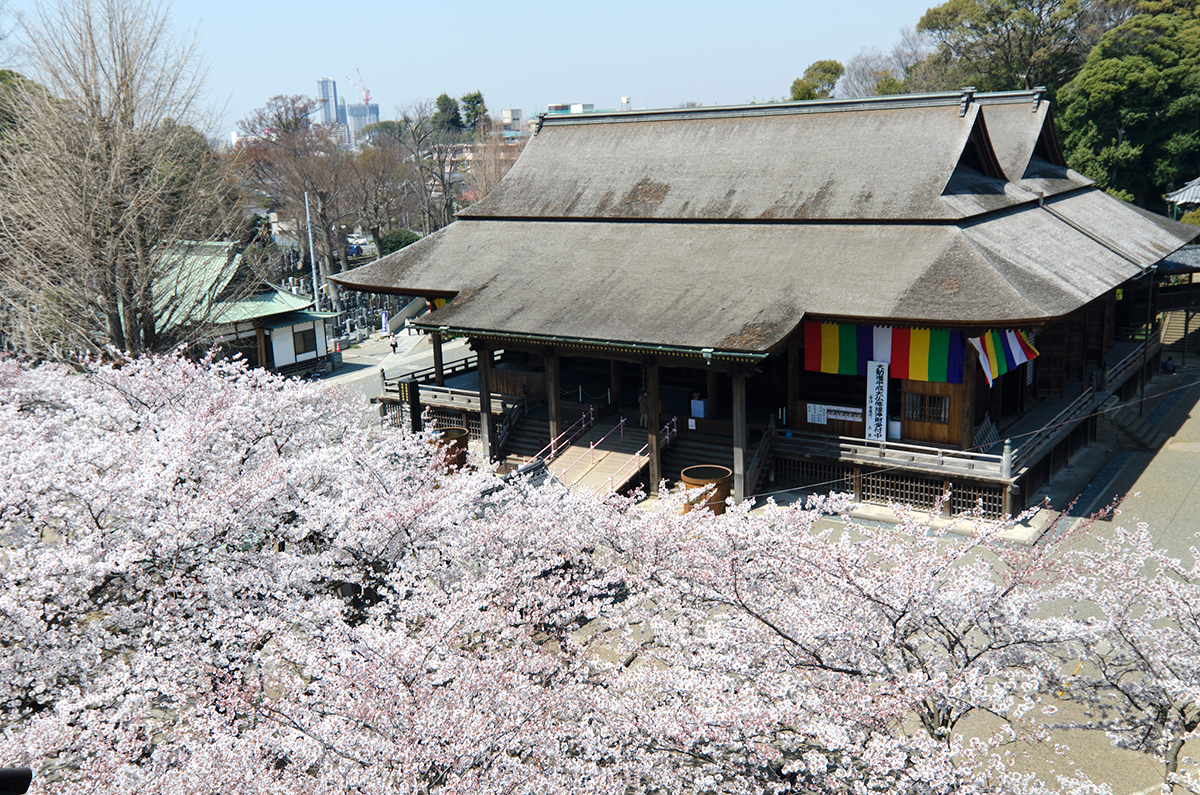
narration

Hokekyōji is a Nichiren Buddhist temple. Founded in 1260 as a small family temple, Hokekyōji is now one of the major temples of Nichiren Buddhism. Nichiren (1222–1282) was a Buddhist monk who taught that the Lotus Sutra represents the ultimate teaching of the Buddha. Fleeing persecution from the Kamakura shogunate, Nichiren came to Shimousa (now Ichikawa) in 1260 to stay with his disciple Toki Jōnin (1216–1299). Toki built the first temple buildings on his estate during the Kamakura period (1185–1333). The temple contains a number of National Treasures and Important Cultural Properties.
According to Nichiren, anyone can achieve enlightenment by chanting the phrase “Namu myōhō renge kyō,” meaning “Devotion to the Wonderful Truth of the Lotus Sutra.” Hokekyōji takes its name from the sutra’s title; it literally is the “Lotus Sutra Temple.” Nichiren’s teachings are the basis of Nichiren Buddhism, which is now one of the largest Buddhist schools in Japan.
The grounds of Hokekyōji are centered on the Soshidō, or “Founder’s Hall,” which dates to 1678. The hall was first built in 1325 as a smaller structure, but it has been rebuilt several times. The hall has an elegant double roof—a rare feature for a Buddhist temple. The roof design may have been modeled on Okayama Prefecture’s Kibitsu Shrine, which was built in the fifteenth century. Kibitsu’s worship hall has the only other extant example of a hiyoku irimoya-zukuri (twin hip-and-gable roof). Wooden plaques found inside the Soshidō describe an earlier repair in 1601.
Inside the Soshidō, a statue of Nichiren is housed in a large altar decorated with gold leaf. The coffered vermilion ceiling is adorned with paintings of Chinese bellflowers. Most of the exterior walls can be opened and the partitions in the hall rearranged to accommodate large groups, such as on certain holy days when Nichiren monks gather there. The interior and exterior of the Soshidō were restored in a long-term renovation project completed in 1997, at which time the structure was placed on a concrete foundation to make it more resistant to earthquakes.
Immediately behind the Soshidō is the Hokkedō, or “Lotus Sutra Hall,” which houses the temple’s principal object of worship. The Hokkedō was the first hall built by Toki Jōnin. It is fronted by the Shisokumon, a gate notable for its upturned roof supported by wooden columns. Both structures were completed in the late Muromachi period (1336–1573) and are designated Important Cultural Properties.
Behind the Soshidō stands the Shōgyōden, or “Sacred Sutra Hall.” It was designed by the architect Itō Chūta (1867–1954) and completed in 1931. Its unusual style was inspired by temples in India, and a similarly inspired design—also by Itō—can be seen at Tsukiji Honganji Temple in Tokyo. The Shōgyōden is built of reinforced concrete. As suggested by its name, it is used to store sacred documents and other relics like the Risshō ankoku ron, a treatise written by Nichiren in 1260. The treatise and several of the other documents are National Treasures.
A five-storied pagoda stands outside the Soshidō. Pagodas derive from stupas built in South and Southeast Asia. They are traditionally used to enshrine relics of the historical Buddha, Shakyamuni, and serve as reminders of the Buddha’s teachings. Hon’ami Kōshitsu (1583–1625), an official sword appraiser to the shogunate, sponsored construction of Hokekyōji’s five-storied pagoda as a memorial to his dead parents with the support of the lord of Kaga, Maeda Toshimitsu (1594–1658). Standing approximately 30 meters tall, the pagoda was completed in 1622. It was designated an Important Cultural Property in 1916.
The road that leads to Hokekyōji begins at the Kuromon or “Black Gate.” Approximately 230 meters beyond the Kuromon is the Niōmon, or “Benevolent Kings Gate,” a grand structure housing the statues of two muscular warrior figures who protect the Buddha and Buddhism from evil forces. Beyond the gate stretches a 200-meter-long walkway lined with branch temples and cherry trees that leads to Hokekyōji’s main compound.